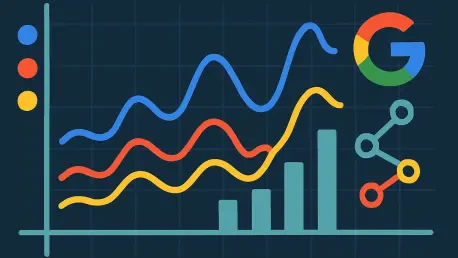Google’s recent unveiling of the Trends API marks a significant transformation in how data accessibility is approached, providing programmatic access to its vast repository of search trends data. Introduced to the public on July 24, 2025, this innovative tool is poised to address the ever-growing demand among researchers, journalists, and developers for more sophisticated analysis of shifting search behavior patterns. By facilitating access that grants users a multitude of options for obtaining detailed search trends information, this API represents a pivotal shift from traditional methods reliant on Google’s web interface. Offering a rolling window of 1,800 days of search interest data, this initiative promises deeper insights with the ability to view information nearly in real-time, up to two days before a request is made.
Improving Data Accessibility
Introducing Programmatic Access
Google’s Trends API emerges as a game changer by providing an automated means to access extensive data on search trends. This functionality showcases Google’s commitment to addressing the evolving needs of data-driven professionals and businesses, who can now effortlessly obtain relevant information without manual interference. With four aggregation intervals available—daily, weekly, monthly, and yearly—the API accommodates diverse analysis requirements, allowing users to integrate detailed trends data seamlessly with other reporting systems. This flexibility not only optimizes research efforts but also enhances the capability to track patterns over time, addressing previous limitations in the scope of analysis.
One standout feature of the API is its promise of scaled data consistency across multiple requests, contrasting the traditional Google Trends web model, which often required users to independently adjust scaling for each query. This automated consistency eradicates previous challenges, enabling a more efficient analysis process by mitigating the need for complex rescaling when handling large datasets. Furthermore, the API’s support for geographic data aligns with the ISO 3166-2 standard, paving the way for region-specific and subregional breakdowns for more localized studies. This facility is expected to bolster research endeavors by granting access to meaningful data insights tailored to specific geographical contexts.
Allowing Comparisons
The introduction of Google’s Trends API signifies a leap forward in innovation and usability by tackling inherent limitations posed by the pre-existing website interface. Recognizing the growing demand for enhanced analytical capabilities, the API eliminates the five-term comparison constraint, thus permitting multifaceted research approaches. Researchers, marketers, and other stakeholders can now conduct detailed comparisons across various search terms, enhancing the scope for competitive analysis and market research. This removal of limitations thus broadens the capability for intricate studies, offering benefits such as tracking brand perception changes and analyzing consumer behavior over time.
This access underscores Google’s strategic focus on empowering users by providing advanced tools needed to navigate the dynamic data-centric landscape of contemporary search marketing. Such tools are essential for businesses keen on deepening their understanding of consumer patterns and market positions, allowing for better-informed strategic decisions. By offering this robust framework, the Trends API introduces possibilities for complex, longitudinal studies that challenge users to delve deeper into trends analysis and comprehension, surpassing what was previously achievable.
Implications for Users
Refining Marketing Strategies
For marketing professionals, the geographic capabilities provided by the Trends API offer a newfound depth for constructing refined strategies. Insights into location-specific trends allow businesses to adjust advertising campaigns tailored to local markets, representing a significant advantage in competitive landscapes. Access to subregional data proves particularly valuable for enterprises wishing to investigate geographic expansion or evaluate market entry tactics in specific areas. Through these extensive capabilities, marketing teams can devise targeted campaigns optimized to enhance reach and engagement, subsequently fueling growth and innovation.
Software developers and marketing teams are also equipped to benefit from the API’s potential to incorporate geographic data into strategies with precision, highlighting how localized insights can influence business and advertising decisions. These capabilities prove instrumental for companies keen on aligning products and messaging with specific cultural preferences or market demands, ultimately maximizing market presence and consumer resonance.
Extending Analytical Capabilities
The power of enhanced analytical capabilities extends beyond marketers, paving the way for extended application among researchers and news organizations. Academic researchers can leverage the API’s features to pursue longitudinal studies of social phenomena, brand evolution, and cultural trends. The comprehensive data access mitigates the need for labor-intensive manual data collection, offering efficient solutions for research and scholarly publications. This automation supports evidence-based conclusions, reinforcing the reliability and thoroughness of academic studies.
News organizations equally stand to gain from integrating real-time trend analysis into editorial strategies. The API facilitates automated monitoring of story-related search terms, enabling journalists to identify emerging topics swiftly and curate content that resonates with public interest. This advancement endorses data-driven journalism—a critical component of modern media strategy—allowing for timely and engaging storytelling. As organizations capitalize on these offerings, the impactful delivery of content enhances audience engagement, supporting evolving journalism endeavors.
The Future of Data Insights
Shaping Beta Testing
Google’s structured rollout strategy for the Trends API showcases an incremental access model designed to refine functionalities before a broader release. By prioritizing applicants with concrete use cases and robust feedback mechanisms, Google channels this initiative toward achieving optimal results. The API’s alpha testing phase invites feedback that will influence final aspects such as pricing, rate limits, and commercial availability terms. This strategic approach reveals Google’s commitment towards fostering ethical data accessibility that aligns with the expectations of varied market players, helping ensure successful adoption for widespread applications.
While certain limitations currently exist due to the alpha-only status, the promise of beta testing offers the scope to overcome potential barriers. As developers explore new features, their input will be crucial in steering functionality enhancements that address performance and usability requirements. The refinement phase seeks to lay the groundwork for future API incarnations, catering to developers’ expectations regarding detailed implementation guidelines and integration techniques. Information on authentication methods and rate limiting will likely echo Google’s established standards, a reflection of the company’s dedication to delivering intuitive and empowering developer solutions.
Enabling Automation
The Google Trends API offers promising prospects for enhancing trend analysis workflows across varied sectors. It replaces manual data retrieval tasks by facilitating automated collection, streamlining processes for agencies managing numerous clients or competitors. Consistently scaled data proves advantageous for businesses facing seasonal changes, encouraging seamless analyses in accordance with year-over-year trends without the complexities of data normalization. This automation underscores the role of efficiency in optimizing research practices, granting users the flexibility to focus on extracting valuable insights from the data.
Furthermore, academic researchers exploring brand evolution and cultural trends benefit from the API’s long-term capabilities without being encumbered by intensive manual data collection. The holistic data access supports comprehensive studies, generating insights that substantiate evidence-based conclusions and elevate scholarly explorations. This contribution to academia reaffirms the API’s role as a vital instrument in fostering innovation across educational research, enriching methodologies that integrate quantitative and qualitative observations.
Exploring New Dimensions
Global Understanding
Businesses pursuing international expansion appreciate the API’s geographic breakdown features, aiding in understanding cross-cultural search behaviors. These insights promote finely tuned marketing messages that conform to regional trends, ensuring resonance with diverse cultural preferences. By unraveling global nuances in search patterns, companies enrich their strategic positioning, fostering growth in untapped markets. Academic research in disparate disciplines also leverages these geographic insights to substantiate qualitative observations surrounding cultural differences and societal shifts.
This integration of geographic data into broader strategic frameworks widens the scope for both businesses and researchers, allowing for shared perspectives that contribute to refined global practices. The API’s influence traverses across industries, promoting informed decision-making and adaptive methodologies that respond to geo-specific challenges, ensuring relevance and sustainable progression in the long term.
Unveiling New Opportunities
Designed to cover events with frequent cycles within its five-year data window, the Trends API affirms its capacity to engage with substantial examinations. These cycles, including presidential elections and global sporting competitions such as the Olympics and World Cup, foster research focused on analyzing trends around such events to drive insights. Through manageable data volumes, Google’s initiative aligns effectively with critical research requirements, facilitating comprehensive studies.
Input gathered during alpha testing influences facets of the API’s final iteration, underpinning aspects like pricing and terms of availability. However, challenges remain due to limited current access and uncertain commercial timelines. These obstacles highlight the ongoing evolution of the API, inviting feedback that steers performance enhancements and fulfills dynamic user needs. Google’s emphasis on ethical adoption ensures an array of possibilities that broaden perspectives on data engagement in the digital ecosystem.
Concluding Insights
Google’s introduction of the Trends API represents a groundbreaking enhancement in the way search data is transformed into automated analytic platforms. This development reflects a growing trend towards advanced, data-driven methodologies that are supported by programmatic capabilities. These capabilities are increasingly vital for a wide array of industry players who rely on data to drive their decisions and strategies. Google’s rollout of the Trends API was characterized by well-organized plans and a variety of features, underscoring the company’s commitment to shaping the future of digital research and search marketing.
The API is a significant step forward in the pursuit of deep insights, solidifying Google’s influential position in the ever-evolving technology landscape. By offering this innovative tool, Google is set to empower researchers, marketers, and decision-makers, providing them with the tools necessary to make informed strategic choices. As a result, this initiative charts a progressive course for the future of data accessibility and utilization.
The promise of enhanced capabilities in analyzing and understanding search trends heralds a new era in which data can be harnessed more effectively than ever before. Google’s Trends API not only highlights the company’s dedication to maintaining its role as a leader but also opens new opportunities for innovation and growth in various sectors dependent on data insights.









